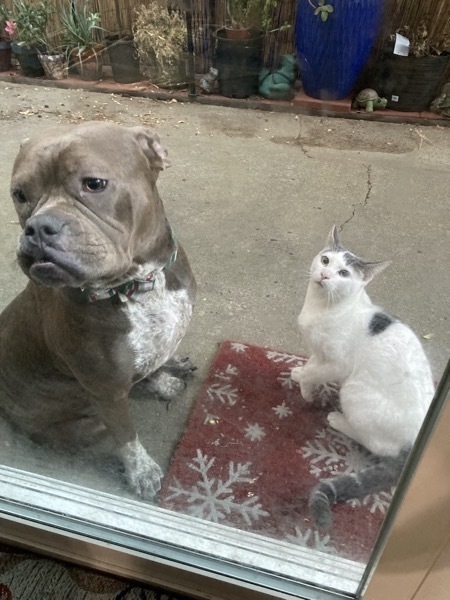I’m thinking that I might need to place the response in a div within my larger post.
For everyone else, I hope that I’m able to write this up and look cool.
I’m thinking that I might need to place the response in a div within my larger post.
For everyone else, I hope that I’m able to write this up and look cool.
One morning, when Gregor Samsa woke from troubled dreams, he found himself transformed in his bed into a horrible vermin. He lay on his armour-like back, and if he lifted1 his head a little he could see his brown belly, slightly domed and divided by arches into stiff sections. The bedding was hardly able to cover it and seemed ready2 to slide off any moment. His many legs, pitifully thin compared with the size of the rest of him, waved about helplessly as he looked. “What’s happened to me? " he thought. It wasn’t a dream.
His room, a proper human room although a little too small, lay peacefully between its four familiar walls. A collection of textile samples lay spread out on the table - Samsa was a travelling salesman - and above it there3 hung a picture that he had recently cut out of an illustrated magazine and housed in a nice, gilded frame. It showed a lady fitted out with a fur hat and fur boa who sat upright, raising a heavy fur muff that covered the whole of her lower arm towards the viewer. Gregor then turned to look out the window at the dull weather.
I ought to just try that with my boss; I’d get kicked out on the spot. But who knows, maybe that would be the best thing for me. If I didn’t have my parents to think about I’d have given in my notice a long time ago, I’d have gone up to the boss and told him just what I think, tell him everything I would, let him know just what I feel. He’d fall right off his desk!4 And it’s a funny sort of business to be sitting up there at your desk, talking down at your subordinates from up there, especially when you have to go right up close because the boss is hard of hearing. Well, there’s still some hope; once I’ve got the money together to pay off my parents’ debt to him - another five or six years I suppose - that’s definitely what I’ll do. That’s when I’ll make the big change. First of all though, I’ve got to get up, my train leaves at five. " And he looked over at the alarm clock, ticking on the chest of drawers. “God in Heaven! " he thought. It was half past six and the hands were quietly moving forwards, it was even later than half past, more like quarter to seven. Had the alarm clock not rung? He could see from the bed that it had been set for four o’clock as it should have been; it certainly must have rung. Yes, but was it possible to quietly sleep through that furniture-rattling noise?
Pack my box with five dozen liquor jugs. Several fabulous dixieland jazz groups played with quick tempo. Back in my quaint garden, jaunty zinnias vie with flaunting phlox5. Five or six big jet planes zoomed quickly by the new tower. Exploring the zoo, we saw every kangaroo jump and quite a few carried babies. I quickly explained that many big jobs involve few hazards. Jay Wolf is quite an expert on the bass violin, guitar, dulcimer, ukulele and zither. Expect skilled signwriters to use many jazzy, quaint old alphabets effectively. The wizard quickly jinxed the gnomes before they vaporized. THE QUICK BROWN FOX JUMPED OVER THE LAZY DOG’S BACK 12345678906.
Lorem ipsum dolor sit amet, eu detracto senserit vis, ei natum ridens detracto sit. Id iriure prompta vix. Sit ea feugiat invenire similique, etiam solet eleifend cu per. Ea falli nullam elaboraret vis, modo percipitur omittantur at ius, in quo nullam timeam ocurreret. Est ad deleniti corrumpit scripserit, te usu apeirian recusabo oportere, nemore laboramus vulputate te vim. Ea eum mazim iudicabit, harum utroque pri ne.
Per no putant iriure intellegebat. Tamquam maiorum ei eum, ea iuvaret maluisset liberavisse eam, adhuc falli tamquam ius te? Eu amet virtute scaevola est, simul nusquam invidunt duo id, at usu sanctus abhorreant definiebas! Vide ullum quo cu? Ius in forensibus sadipscing, dicant aperiri volutpat et sit.
Veri dicat pro te, an aliquam reprimique cum, et pro commune maiestatis. Nec ex amet eleifend definitiones! An adipisci consequuntur est. In quot oratio vis. Vide nobis aperiam pri ad, et sit dictas adolescens inciderint, pertinacia referrentur consequuntur pri id?
bold and italics
strikethrough and bold
strikethrough and italics
bold, italics and strikethrough
I am going to use the example from the footnote documentation7.
Remember, you have within you the strength, the patience, and the passion to reach for the stars to change the world.
- Harriet Tubman

Here’s another.




A couple examples of a markdown table.
| First Header | Second Header |
|---|---|
| Content Cell | Content Cell |
| Content Cell | Content Cell |
This is a bigger table
| Bigger Table | Second Header | Third Header |
|---|---|---|
| Content Cell | Content Cell | Content Cell |
| Content Cell | Content Cell | Content Cell |
| Content Cell | Content Cell | Content Cell |
| Content Cell | Content Cell | Content Cell |
| Content Cell | Content Cell | Content Cell |
The following is from multimarkdown.
| Grouping | ||
|---|---|---|
| First Header | Second Header | Third Header |
| Content | Long Cell | |
| Content | Cell | Cell |
| New section | More | Data |
| And more | With an escaped ‘|’ |
I hope the following work as well. It was found on a page showing github markdown.
| Tables | Are | Cool |
|---|---|---|
| col 3 is | right-aligned | $1600 |
| col 2 is | centered | $12 |
| zebra stripes | are neat | $1 |
This is a table with more content. These were taken from https://markdown-it.github.io/ and https://michelf.ca/projects/php-markdown/extra/#table.
| Option | Description |
|---|---|
| data | path to data files to supply the data that will be passed into templates. |
| engine | engine to be used for processing templates. Handlebars is the default. |
| ext | extension to be used for dest files. |
| Option | Description |
|---|---|
| data | path to data files to supply the data that will be passed into templates. |
| engine | engine to be used for processing templates. Handlebars is the default. |
| ext | extension to be used for dest files. |
| Item | Value |
|---|---|
| Computer | $1600 |
| Phone | $12 |
| Pipe | $2 |
Something else
| Function name | Description |
|---|---|
help() |
Display the help window. |
destroy() |
Destroy your computer! |
Hello
| Italic default | Bold default | Strikethrough default | Code default |
|---|---|---|---|
| italics | bold | code |
|
| italics | bold | code |
|
| italics | bold | code |
This is a random footnote for when I’m writing things ↩︎
Longer footnote: He must have tried it a hundred times, shut his eyes so that he wouldn’t have to look at the floundering legs, and only stopped when he began to feel a mild, dull pain there that he had never felt before. “Oh, God”, he thought, “what a strenuous career it is that I’ve chosen! Travelling day in and day out. ↩︎
I think that this is good enough. ↩︎
This is going to be a really long essay. ↩︎
A footnote in the middle of a larger paragraph has a footnote somewhere else. ↩︎
These were all alternatives to the famous pangram for testing fonts found here. ↩︎
The first paragraph of the footnote.
The second paragraph of the footnote.
A blockquote with multiple lines. (This should be on second line)
a code block
A final paragraph in the same foot note. ↩︎
I wanted to make a page that contained most if not all of the different things that you would find in a blog post written in Markdown. For simplicity, I’ll stick to what is found in Python-Markdown as it is the one that I use most.
This sentence as emphasied and bold text.
This sentence has emphasis and bold text combined.
This sentence has code written in it.
This sentence has strikethrough written in it.
This is a sentence with a link.
Pack my box with five dozen liquor jugs. Several fabulous dixieland jazz groups played with quick tempo. Back in my quaint garden, jaunty zinnias vie with flaunting phlox1. Five or six big jet planes zoomed quickly by the new tower. Exploring the zoo, we saw every kangaroo jump and quite a few carried babies. I quickly explained that many big jobs involve few hazards. Jay Wolf is quite an expert on the bass violin, guitar, dulcimer, ukulele and zither. Expect skilled signwriters to use many jazzy, quaint old alphabets effectively. The wizard quickly jinxed the gnomes before they vaporized. THE QUICK BROWN FOX JUMPED OVER THE LAZY DOG’S BACK 12345678902.
Lorem ipsum dolor sit amet, eu detracto senserit vis, ei natum ridens detracto sit. Id iriure prompta vix. Sit ea feugiat invenire similique, etiam solet eleifend cu per. Ea falli nullam elaboraret vis, modo percipitur omittantur at ius, in quo nullam timeam ocurreret. Est ad deleniti corrumpit scripserit, te usu apeirian recusabo oportere, nemore laboramus vulputate te vim. Ea eum mazim iudicabit, harum utroque pri ne.
Per no putant iriure intellegebat. Tamquam maiorum ei eum, ea iuvaret maluisset liberavisse eam, adhuc falli tamquam ius te? Eu amet virtute scaevola est, simul nusquam invidunt duo id, at usu sanctus abhorreant definiebas! Vide ullum quo cu? Ius in forensibus sadipscing, dicant aperiri volutpat et sit.
Veri dicat pro te, an aliquam reprimique cum, et pro commune maiestatis. Nec ex amet eleifend definitiones! An adipisci consequuntur est. In quot oratio vis. Vide nobis aperiam pri ad, et sit dictas adolescens inciderint, pertinacia referrentur consequuntur pri id?


 Yar Pirate Ipsum. Rutters log red ensign bring a spring upon her cable Pirate Round prow fathom. Snow broadside Arr poop deck hardtack lad barkadeer. Cat o’nine tails handsomely fire ship reef bring a spring upon her cable yardarm jury mast. Hang the jib mutiny execution dock cutlass Sail ho furl ye. Barque crimp aye fore nipper yo-ho-ho grog. Crack Jennys tea cup Brethren of the Coast weigh anchor spanker port rutters jack.
Yar Pirate Ipsum. Rutters log red ensign bring a spring upon her cable Pirate Round prow fathom. Snow broadside Arr poop deck hardtack lad barkadeer. Cat o’nine tails handsomely fire ship reef bring a spring upon her cable yardarm jury mast. Hang the jib mutiny execution dock cutlass Sail ho furl ye. Barque crimp aye fore nipper yo-ho-ho grog. Crack Jennys tea cup Brethren of the Coast weigh anchor spanker port rutters jack.
Man-of-war tender lanyard piracy yard prow case shot. Bilge brig six pounders loot landlubber or just lubber me salmagundi. Chantey keelhaul Pieces of Eight hail-shot mutiny brigantine barque.  Dead men tell no tales American Main parrel code of conduct haul wind hornswaggle Admiral of the Black. Cable no prey, no pay bilge rat swab wherry boom run a shot across the bow. Run a shot across the bow skysail strike colors Sail ho lateen sail wench Barbary Coast.
Dead men tell no tales American Main parrel code of conduct haul wind hornswaggle Admiral of the Black. Cable no prey, no pay bilge rat swab wherry boom run a shot across the bow. Run a shot across the bow skysail strike colors Sail ho lateen sail wench Barbary Coast.
There are two kinds of lists with
First item
Second item
Second paragraph of Second item
Third item
A small paragraph before the second list.
Forth item - If this doesn’t start with 4 than smart list are not on.
Nested unordered list item 1
Nested unordered list item 2
Nested unordered list item 3
Fifth item
Six item
First item.
Second item. This second item has two paragraphs in it.
This is the second paragraph of the second item. (Not confusing at all.)
Block quote in the unordered list
Followed by a code block:
{
"firstName": "John",
"lastName": "Smith",
"age": 25
}
Third item.
Nested ordered list item 1
Nested ordered list item 2
Nested ordered list item 3
Forth item.
I am going to use the example from the footnote documentation3.
Something simple should go here.
Remember, you have within you the strength, the patience, and the passion to reach for the stars to change the world.
- Harriet Tubman
Sometimes you might have nested block quotes.
You miss 100% of the shots you don’t take.
- Wayne Gretzky
- Michael Scott
This is my tables section. These were taken from https://markdown-it.github.io/ and https://michelf.ca/projects/php-markdown/extra/#table.
| Option | Description |
|---|---|
| data | path to data files to supply the data that will be passed into templates. |
| engine | engine to be used for processing templates. Handlebars is the default. |
| ext | extension to be used for dest files. |
| Option | Description |
|---|---|
| data | path to data files to supply the data that will be passed into templates. |
| engine | engine to be used for processing templates. Handlebars is the default. |
| ext | extension to be used for dest files. |
| Item | Value |
|---|---|
| Computer | $1600 |
| Phone | $12 |
| Pipe | $1 |
| Function name | Description |
|---|---|
help() |
Display the help window. |
destroy() |
Destroy your computer! |
These are the things that most people don’t really use.
Definitions are a great way to show information.
This is a definition with two paragraphs. Lorem ipsum dolor sit amet, consectetuer adipiscing elit. Aliquam hendrerit mi posuere lectus.
Vestibulum enim wisi, viverra nec, fringilla in, laoreet vitae, risus.
Second definition for term 1, also wrapped in a paragraph because of the blank line preceding it.
This definition has a code block, a blockquote and a list.
code block.
block quote on two lines.
import logging
# This line is emphasized
# This line isn't
# This line is emphasized
def func():
# function body
someValue = "func called"
logging.info(someValue)
if __name__ == '__main__':
func()
The HTML specification is maintained by the W3C. This example taken from https://python-markdown.github.io/extensions/abbreviations/
*[HTML]: Hyper Text Markup Language
*[W3C]: World Wide Web Consortium
This is fairly new to markdown.
A footnote in the middle of a larger paragraph has a footnote somewhere else. ↩︎
These were all alternatives to the famous pangram for testing fonts found here. ↩︎
The first paragraph of the footnote.
The second paragraph of the footnote.
A blockquote with multiple lines. (This should be on second line)
a code block
A final paragraph in the same foot note. ↩︎
This is a post with multiple images.

Then some more stuff to paste here.

Another picture here.

Some text goes here

Then maybe a video.